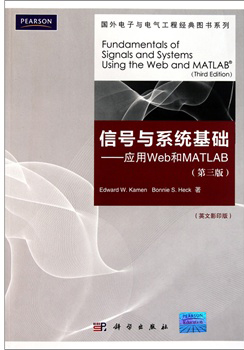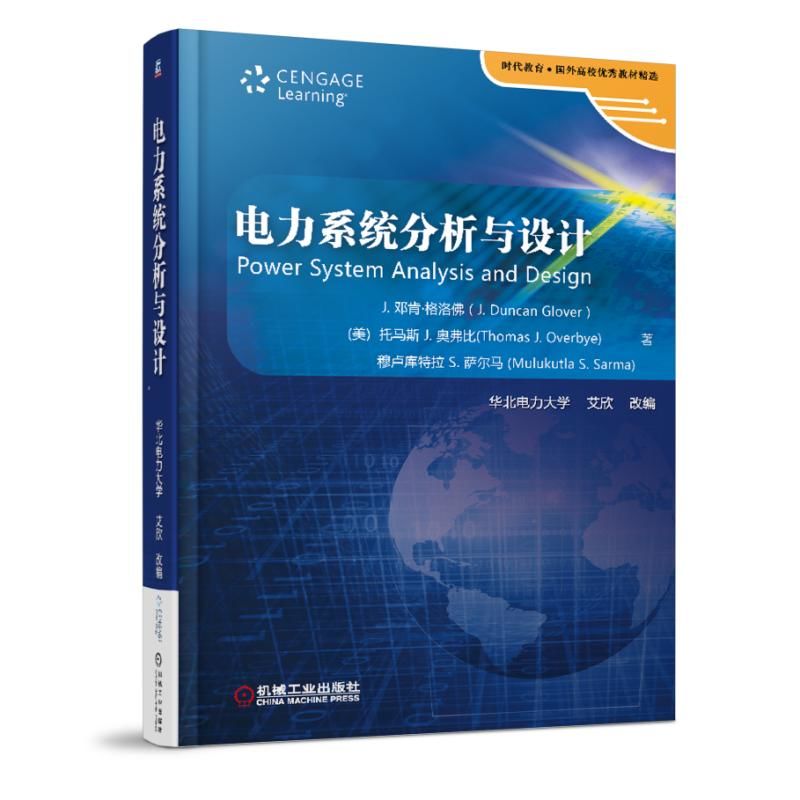信号与系统基础——应用Web和Matlab(第三版)(影印) / 国外电子与电气工程经典图书系列
定价:¥118.00
作者: Edward W.Kamen
出版时间:2016-02
出版社:科学出版社
- 科学出版社
- 9787030318114
- 1-3
- 36984
- 45179880-5
- 平装
- 16开
- 2016-02
- 1000
- 656
- TN911.6
- 电子信息、通信等
- 本科
内容简介
《信号与系统基础——应用web与matlab(第3版)(影印版)》介绍了信号与系统的基本理论、基本分析方法及其应用,包括11章内容:第1章到第7章是信号与系统的基本内容,讨论了时域中信号与系统的各种特性以及连续和离散时间系统的各种模型;从频域的观点分析了信号与系统,讨论了离散时间傅里叶变换(DTFT)和离散傅里叶变换(DFT),系统的傅里叶分析,拉普拉斯变换,z变换和线性时不变系统的传输函数表示法等内容;第8章以后为扩展内容,包括利用传输函数表示法分析线性时不变连续时间系统,将传输函数思想用于控制问题;将拉普拉斯和z变换的思想用于数字滤波器和控制器的设计;对线性时不变连续时间和离散时间系统的状态描述的基本理论进行了阐述。另外,《信号与系统基础——应用web与matlab(第3版)(影印版)》还给出了大量的MATLAB软件仿真实例。
目录
Contents
Preface v
CHAPTER 1 Fundamental Concepts 1
1.1 Continuous-Time Signals 1
1.2 Discrete-Time Signals 11
1.3 Systems 21
1.4 Examples of Systems 24
1.5 Basic System Properties 31
1.6 Chapter Summary 37
Problems 37
CHAPTER 2 Time-Domain Models of Systems 44
2.1 Input/Output Representation of Discrete-Time Systems 44
2.2 Convolution of Discrete-Time Signals 49
2.3 Difference Equation Models 55
2.4 Differential Equation Models 64
2.5 Solution of Differential Equations 69
2.6 Convolution Representation of Continuous-Time Systems 75
2.7 Chapter Summary 84
Problems 85
CHAPTER 3 The Fourier Series and Fourier Transform 96
3.1 Representation of Signals in Terms of Frequency Components 96
3.2 Trigonometric Fourier Series 101
3.3 Complex Exponential Series 108
3.4 Fourier Transform 114
3.5 Spectral Content of Common Signals 122
3.6 Properties of the Fourier Transform 126
3.7 Generalized Fourier Transform 141
3.8 Application to Signal Modulation and Demodulation 144
3.9 Chapter Summary 152
Problems 154
CHAPTER 4 Fourier Analysis of Discrete-Time Signals 166
4.1 Discrete-Time Fourier Transform 166
4.2 Discrete Fourier Transform 179
4.3 DFT of Truncated Signals 188
4.4 FFT Algorithm 195
4.5 Application to Data Analysis 206
4.6 Chapter Summary 216
Problems 217
CHAPTER 5 Fourier Analysis of Systems 222
5.1 Fourier Analysis of Continuous-Time Systems 222
5.2 Response to Periodic and Nonperiodic Inputs 228
5.3 Analysis of Ideal Filters 237
5.4 Sampling 242
5.5 Fourier Analysis of Discrete-Time Systems 249
5.6 Application to Lowpass Digital Filtering 254
5.7 Chapter Summary 262
Problems 263
CHAPTER 6 The Laplace Transform and the Transfer Function Representation 279
6.1 Laplace Transform of a Signal 279
6.2 Properties of the Laplace Transform 285
6.3 Computation of the Inverse Laplace Transform 296
6.4 Transform of the Input/Output Differential Equation 316
6.5 Transform of the Input/Output Convolution Integral 323
6.6 Direct Construction of the Transfer Function 330
6.7 Chapter Summary 341
Problems 342
CHAPTER 7 The z-Transform and Discrete-Time Systems 352
7.1 z-Transform of a Discrete-Time Signal 352
7.2 Properties of the z-Transform 357
7.3 Computation of the Inverse z-Transform 367
7.4 Transfer Function Representation 377
7.5 System Analysis Using the Transfer Function Representation 388
7.6 Chapter Summary 400
Problems 401
CHAPTER 8 Analysis of Continuous-Time Systems by Use of the Transfer Function Representation 411
8.1 Stability and the Impulse Response 411
8.2 Routh-Hurwitz Stability Test 414
8.3 Analysis of the Step Response 419
8.4 Response to Sinusoids and Arbitrary Inputs 437
8.5 Frequency Response Function 443
8.6 Causal Filters 463
8.7 Chapter Summary 478
Problems 479
CHAPTER 9 Application to Control 489
9.1 Introduction to Control 489
9.2 Tracking Control 497
9.3 Root Locus 508
9.4 Application to Control System Design 516
9.5 Chapter Summary 525
Problems 526
CHAPTER 10 Design of Digital Filters and Controllers 536
10.1 Discretization 536
10.2 Design of IIR Filters 543
10.3 Design of IIR Filters Using MATLAB 549
10.4 Design of FIR Filters 556
10.5 Design of Digital Controllers 568
10.6 Chapter Summary 577
Problems 578
CHAPTER 11 State Representation 584
11.1 State Model 584
11.2 Construction of State Models 587
11.3 Solution of State Equations 595
11.4 Discrete-Time Systems 604
11.5 Equivalent State Representations 612
11.6 Discretization of State Model 618
11.7 Chapter Summary 622
Problems 623
Appendix A Brief Review of Complex Variables 633
Appendix B Brief Review of Matrices 638
Bibliography 644
Preface v
CHAPTER 1 Fundamental Concepts 1
1.1 Continuous-Time Signals 1
1.2 Discrete-Time Signals 11
1.3 Systems 21
1.4 Examples of Systems 24
1.5 Basic System Properties 31
1.6 Chapter Summary 37
Problems 37
CHAPTER 2 Time-Domain Models of Systems 44
2.1 Input/Output Representation of Discrete-Time Systems 44
2.2 Convolution of Discrete-Time Signals 49
2.3 Difference Equation Models 55
2.4 Differential Equation Models 64
2.5 Solution of Differential Equations 69
2.6 Convolution Representation of Continuous-Time Systems 75
2.7 Chapter Summary 84
Problems 85
CHAPTER 3 The Fourier Series and Fourier Transform 96
3.1 Representation of Signals in Terms of Frequency Components 96
3.2 Trigonometric Fourier Series 101
3.3 Complex Exponential Series 108
3.4 Fourier Transform 114
3.5 Spectral Content of Common Signals 122
3.6 Properties of the Fourier Transform 126
3.7 Generalized Fourier Transform 141
3.8 Application to Signal Modulation and Demodulation 144
3.9 Chapter Summary 152
Problems 154
CHAPTER 4 Fourier Analysis of Discrete-Time Signals 166
4.1 Discrete-Time Fourier Transform 166
4.2 Discrete Fourier Transform 179
4.3 DFT of Truncated Signals 188
4.4 FFT Algorithm 195
4.5 Application to Data Analysis 206
4.6 Chapter Summary 216
Problems 217
CHAPTER 5 Fourier Analysis of Systems 222
5.1 Fourier Analysis of Continuous-Time Systems 222
5.2 Response to Periodic and Nonperiodic Inputs 228
5.3 Analysis of Ideal Filters 237
5.4 Sampling 242
5.5 Fourier Analysis of Discrete-Time Systems 249
5.6 Application to Lowpass Digital Filtering 254
5.7 Chapter Summary 262
Problems 263
CHAPTER 6 The Laplace Transform and the Transfer Function Representation 279
6.1 Laplace Transform of a Signal 279
6.2 Properties of the Laplace Transform 285
6.3 Computation of the Inverse Laplace Transform 296
6.4 Transform of the Input/Output Differential Equation 316
6.5 Transform of the Input/Output Convolution Integral 323
6.6 Direct Construction of the Transfer Function 330
6.7 Chapter Summary 341
Problems 342
CHAPTER 7 The z-Transform and Discrete-Time Systems 352
7.1 z-Transform of a Discrete-Time Signal 352
7.2 Properties of the z-Transform 357
7.3 Computation of the Inverse z-Transform 367
7.4 Transfer Function Representation 377
7.5 System Analysis Using the Transfer Function Representation 388
7.6 Chapter Summary 400
Problems 401
CHAPTER 8 Analysis of Continuous-Time Systems by Use of the Transfer Function Representation 411
8.1 Stability and the Impulse Response 411
8.2 Routh-Hurwitz Stability Test 414
8.3 Analysis of the Step Response 419
8.4 Response to Sinusoids and Arbitrary Inputs 437
8.5 Frequency Response Function 443
8.6 Causal Filters 463
8.7 Chapter Summary 478
Problems 479
CHAPTER 9 Application to Control 489
9.1 Introduction to Control 489
9.2 Tracking Control 497
9.3 Root Locus 508
9.4 Application to Control System Design 516
9.5 Chapter Summary 525
Problems 526
CHAPTER 10 Design of Digital Filters and Controllers 536
10.1 Discretization 536
10.2 Design of IIR Filters 543
10.3 Design of IIR Filters Using MATLAB 549
10.4 Design of FIR Filters 556
10.5 Design of Digital Controllers 568
10.6 Chapter Summary 577
Problems 578
CHAPTER 11 State Representation 584
11.1 State Model 584
11.2 Construction of State Models 587
11.3 Solution of State Equations 595
11.4 Discrete-Time Systems 604
11.5 Equivalent State Representations 612
11.6 Discretization of State Model 618
11.7 Chapter Summary 622
Problems 623
Appendix A Brief Review of Complex Variables 633
Appendix B Brief Review of Matrices 638
Bibliography 644
















